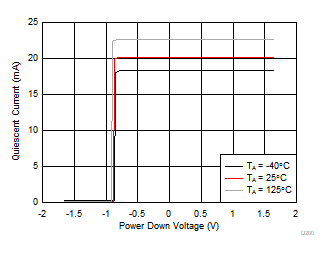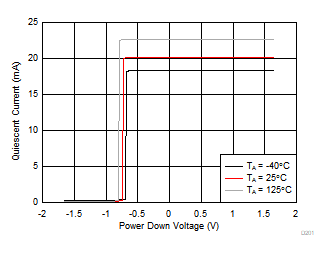JAJSF85A April 2018 – July 2018 OPA858
PRODUCTION DATA.
- 1 特長
- 2 アプリケーション
- 3 概要
- 4 改訂履歴
- 5 Device Comparison Table
- 6 Pin Configuration and Functions
- 7 Specifications
- 8 Parameter Measurement Information
- 9 Detailed Description
- 10Application and Implementation
- 11Power Supply Recommendations
- 12Layout
- 13デバイスおよびドキュメントのサポート
- 14メカニカル、パッケージ、および注文情報
パッケージ・オプション
メカニカル・データ(パッケージ|ピン)
- DSG|8
サーマルパッド・メカニカル・データ
- DSG|8
発注情報
9.4.2 Power-Down Mode
The OPA858 features a power-down mode to reduce the quiescent current to conserve power. Figure 23 and Figure 24 show the transient response of the OPA858 as the PD pin toggles between the disabled and enabled states.
The PD disable and enable threshold voltages are with reference to the negative supply. If the amplifier is configured with the positive supply at 3.3 V and the negative supply at ground, then the disable and enable threshold voltages are 0.65 V and 1.8 V, respectively. If the amplifier is configured with ±1.65-V supplies, then the disable and enable threshold voltages are at –1 V and 0.15 V, respectively. If the amplifier is configured with ±2.5-V supplies, then the threshold voltages are at –1.85 V and –0.7 V.
Figure 54 shows the switching behavior of a typical amplifier as the PD pin is swept down from the enabled state to the disabled state. Similarly Figure 55 shows the switching behavior of a typical amplifier as the PD pin is swept up from the disabled state to the enabled state. The small difference in the switching thresholds between the down sweep and the up sweep is due to the hysteresis designed into the amplifier to increase its immunity to noise on the PD pin.
 Figure 54. Switching Threshold (PD Pin Swept from HIGH to LOW)
Figure 54. Switching Threshold (PD Pin Swept from HIGH to LOW)  Figure 55. Switching Threshold (PD Pin Swept from LOW to HIGH)
Figure 55. Switching Threshold (PD Pin Swept from LOW to HIGH) Connecting the PD pin low disables the amplifier and places the output in a high-impedance state. When the amplifier is configured as a noninverting amplifier, the feedback (RF) and gain (RG) resistor network form a parallel load to the output of the amplifier. To protect the input stage of the amplifier, the OPA858 uses internal, back-to-back protection diodes between the inverting and noninverting input pins as Figure 48 shows. When the differential voltage between the input pins of the amplifier exceeds a diode voltage drop, an additional low-impedance path is created between the inputs.